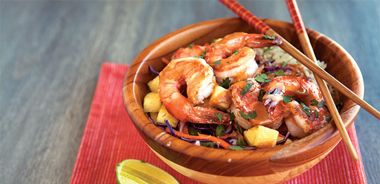Prawn Rice Bowl with Nut Sauce

Serves 4
This rice bowl has it all: taste-of-the-sea prawns, a flavour-packed nut sauce, crunchy vegies and a sweet kick courtesy of pineapple. Bowls are sure to empty quickly.
1 1/4 cups (310 ml) brown jasmine rice
1/4 cup (60 ml) unsalted almond butter or natural peanut butter
6 tsp (30 ml) coconut milk
1 in (2.5 cm) piece of ginger, grated or finely minced
1 garlic clove, grated or finely minced
3 tsp (15 ml) reduced salt soy sauce
3 tsp (15 ml) rice vinegar
2 tsp (10 ml) Asian chilli sauce, such as Sriracha
1 tsp (5 ml) honey
3 cups (750 ml) shredded red cabbage
1 large carrot, shredded
2 spring onions, thinly sliced
3 tsp (15 ml) grapeseed oil or coconut oil
1 lb (450 g) large sustainable prawns, shells removed
1 1/2 cups (350 ml) diced pineapple
1/4 cup (60 ml) fresh coriander
1 lime, sliced into wedges
Place rice and 1 3/4 cups (435 ml) water in medium saucepan. Bring to a boil, reduce heat to low and simmer covered until rice is tender, about 30 minutes. Remove from heat and let stand covered for 10 minutes. Fluff rice with fork.
To make sauce, place nut butter in small bowl and whisk in coconut milk, ginger, garlic, soy sauce, rice vinegar, chilli sauce and honey until smooth. Stir in additional coconut milk if needed to reach desired consistency. In large bowl, combine cabbage, carrot and spring onion.
Heat oil in large skillet over medium heat. Add prawns and cook for 2 minutes on each side, or until pink.
Divide rice among serving bowls and top with vegetables, pineapple, prawns and nut butter sauce. Garnish with coriander and serve with lime wedges.
Each serving contains: 2268 kilojoules; 32 g protein; 18 g total fat (4 g sat. fat, 0 g trans fat); 64 g total carbohydrates (10 g sugars, 5 g fibre); 492 mg sodium
source: "Rice Bowls", alive Australia #23, Autumn 2015





